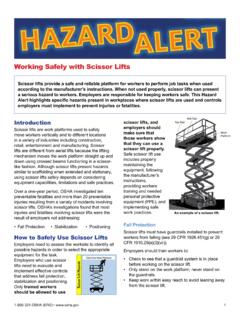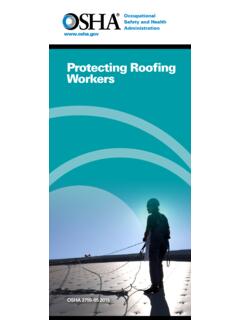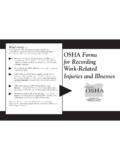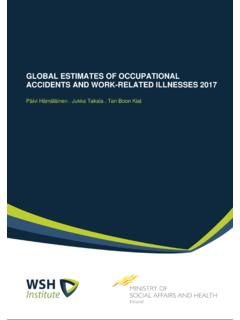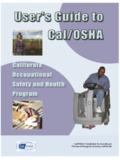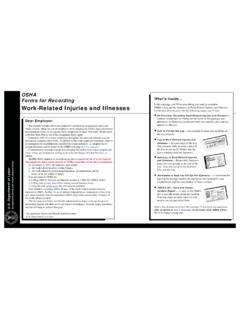Transcription of Occupational Hazards in Home Healthcare
1 DEPARTMENT OF HEALTH AND HUMAN SERVICES centers for disease control and prevention National Institute for Occupational Safety and HealthOccupational Hazards in Home HealthcareNIOSH Hazard revIewNIOSH HAZARD REVIEWO ccupational Hazards in Home HealthcareDEPARTMENT OF HEALTH AND HUMAN SERVICESC enters for disease control and prevention National Institute for Occupational Safety and HealthiiThis document is in the public domain and may be freely copied or of any company or product does not constitute endorsement by the National Institute for Occupational Safety and Health (NIOSH). In addition, citations to Web sites external to NIOSH do not constitute NIOSH endorse-ment of the sponsoring organizations or their programs or products.
2 Further-more, NIOSH is not responsible for the content of these Web InformationTo receive documents or other information about Occupational safety and health topics, contact NIOSH atTelephone: 1 800 CDC INFO (1 800 232 4636)TTY: 1 888 232 6348 E-mail: visit the NIOSH Web site at a monthly update on news at NIOSH, subscribe to NIOSH eNews by visiting (NIOSH) Publication No. 2010 125 January 2010 Safer Healthier PeopleTMiiiForewordAn aging population and rising hospital costs have created new and increas-ing demand for innovative Healthcare delivery systems in the United States. Home Healthcare provides vital medical assistance to ill, elderly, convales-cent, or disabled persons who live in their own homes instead of a Healthcare facility, and is one of the most rapidly expanding industries in this country.
3 The Bureau of Labor Statistics projects that home Healthcare employment will grow 55% between 2006 2016, making it the fastest growing occupation of the next decade. Home Healthcare workers facilitate the rapid and smooth transition of pa-tients from a hospital to a home setting. They offer patients the unique op-portunity to receive quality medical care in the comfort of their own homes rather than in a Healthcare or nursing facility. Home Healthcare workers, while contributing greatly to the well-being of others, face unique risks on the job to their own personal safety and health. During 2007 alone, 27,400 recorded injuries occurred among more than 896,800 home Healthcare Healthcare workers are frequently exposed to a variety of potentially serious or even life-threatening Hazards .
4 These dangers include overexertion; stress; guns and other weapons; illegal drugs; verbal abuse and other forms of violence in the home or community; bloodborne pathogens; needlesticks; latex sensitivity; temperature extremes; unhygienic conditions, including lack of water, unclean or hostile animals, and animal waste. Long commutes from worksite to worksite also expose the home Healthcare worker to trans-portation-related risks. This document aims to raise awareness and increase understanding of the safety and health risks involved in home Healthcare and suggests prevention strategies to reduce the number of injuries , illnesses , and fatalities that too frequently occur among workers in this Howard, Director, National Institute for Occupational Safety and Health Centers for disease control and PreventionvContentsForeword.
5 IiiAbbreviations.. ixAcknowledgments .. xChapter 1 | Background .. References .. 2 Chapter 2 | Musculoskeletal Disorders and Ergonomic Interventions .. Introduction.. What is the impact of musculoskeletal disorders on the home Healthcare industry? .. What are the risk factors for developing musculoskeletal disorders? .. What are some factors that complicate patient transfers? .. What factors contribute to awkward postures?.. What other factors contribute to musculoskeletal disorders?.. Can anything help limit musculoskeletal disorders?.. What can I do to prevent musculoskeletal disorders?.. Recommendations for Employers.
6 Recommendations for Workers.. Resources .. References .. 11 Chapter 3 | Latex Allergy .. Introduction .. What are some sources of exposure to latex? .. What are the effects of latex exposure?.. What is irritant contact dermatitis? .. What is allergic contact dermatitis? .. What is latex allergy?.. What are some products that contain latex?.. How can I prevent exposure to latex? .. Recommendations for Employers.. Recommendations for Workers .. Resources .. References .. 19 Chapter 4 | Exposure to Bloodborne Pathogens and NeedlestickInjuries .. Introduction.. How serious is the risk of exposure from needlestick and sharps injuries ?
7 What regulations should I be aware of?.. What about needleless systems and needle devices with safety features? .. What needleless systems and needle devices with safety features are available?.. How do I select and evaluate needleless systems and needle devices with safety features?.. What can I do to prevent and control needlestick and sharps injuries ? .. Recommendations for Employers.. Recommendations for Workers.. What should I do if I am exposed to the blood of a patient? .. Resources .. References .. 27 Chapter 5 | Occupational Stress .. Introduction.. What are some specific stressors of home Healthcare workers?
8 What can I do to prevent and control Occupational stress? .. Recommendations for Employers.. Recommendations for Workers.. Resources .. References .. 31 Chapter 6 | Violence .. Introduction.. What are some factors that increase the risk of violence to home Healthcare workers?.. What does workplace violence include?.. What are some effects of this violence?.. How can I prevent and control violence in a patient s home? .. Recommendations for Employers .. Recommendations for Workers .. Resources .. References .. 37 Chapter 7 | Other Hazards .. Introduction.. What can I do to prevent and control the occurrence of or exposure to these Hazards ?
9 Infectious Diseases.. Recommendations for Employers.. Recommendations for Workers.. Animals.. Recommendations for Employers.. Recommendations for Workers.. Home Temperature.. Recommendations for Employers.. Recommendations for Workers.. Hygiene.. Recommendations for Employers.. Recommendations for Workers.. Lack of Water .. Recommendations for Employers.. Recommendations for Workers.. Falls.. Recommendations for Employers.. Recommendations for Workers.. Severe Weather.. Recommendations for Employers.. Recommendations for Workers.. Chemical Spills and Acts of Terrorism .. Recommendations for Employers.
10 Recommendations for Workers.. Automobile Travel .. Recommendations for Employers.. Recommendations for Workers.. Resources .. References .. 44 Chapter 8 | Conclusions .. Checklists for Home Healthcare Workers Safety.. 48ixAbbreviationsBLS Bureau of Labor StatisticsCDC Centers for disease control and PreventionFDA Food and Drug AdministrationFEMA Federal Emergency Management AgencyGPS global positioning systemHBV hepatitis B virusHCV hepatitis C virusHIV human immunodeficiency virusIV intravenousNIOSH National Institute for Occupational Safety and Health NRL natural rubber latexOSHA Occupational Safety and Health AdministrationSOII Survey of Occupational injuries and IllnessesTB tuberculosisVA Department of Veterans AffairsxAcknowledgmentsThis document was prepared by the NIOSH Education and Information Divi-sion (EID)










